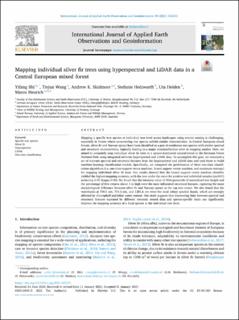| dc.description.abstract | Mapping a specific tree species at individual tree level across landscapes using remote sensing is challenging, especially in forests where co-occurring tree species exhibit similar characteristics. In Central European mixed forests, silver fir and Norway spruce have been identified as a pair of coniferous tree species with similar spectral and structural characteristics, typically leading to a major misclassification error in mapping studies. Here, we aimed to accurately map individual silver fir trees in a spruce-dominated natural forest in the Bavarian Forest National Park using integrated airborne hyperspectral and LiDAR data. To accomplish this goal, we extracted a set of relevant spectral and structural features from the hyperspectral and LiDAR data and used them to build machine learning classification models. Specifically, we compared the performance of three one-class classification algorithms (i.e. one-class support vector machine, biased support vector machine, and maximum entropy) for mapping individual silver fir trees. Our results showed that the biased support vector machine classifier yielded the highest mapping accuracy, with the area under the curve for positive and unlabeled samples (puAUC) achieving 0.95 (kappa 0.90). We found that the intensity value of 95th percentile of normalized tree height and the percentage of first returns above 2 m high were the most influential structural features, capturing the main morphological difference between silver fir and Norway spruce at the top tree crown. We also found that the wavebands at 700.1 nm, 714.5 nm, and 1201.6 nm were the most robust spectral bands, which are strongly affected by chlorophyll and foliar water content. Our study suggests that discovering links between spectral and structural features captured by different remotely sensed data and species-specific traits can significantly improve the mapping accuracy of a focal species at the individual tree level. | en_US |

